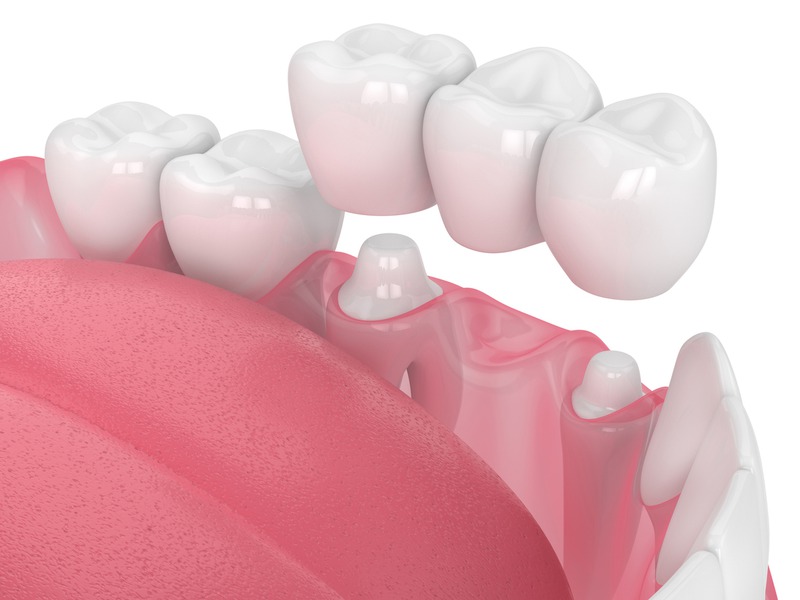Dental health is not just about brushing and flossing; it often involves replacing missing or damaged teeth. One popular option for doing this is ceramic bridges. If you’re considering a ceramic bridge, it’s vital to know what it involves, the benefits, and the potential drawbacks. To make the right choice for your dental health, you’ll want to weigh all of the options carefully. Let’s explore whether ceramic bridges are the right choice for you.
What Are Ceramic Bridges?
Ceramic bridges are dental devices made mainly from ceramic material. They are used to replace missing teeth, literally bridging the gap between two existing teeth. Unlike metal bridges, ceramic ones are highly favored for their aesthetic appeal. They blend in naturally with your teeth, delivering a flawless smile.
How Do Ceramic Bridges Work?
Ceramic bridges consist of a false tooth called a pontic, which is anchored in place by dental crowns on the adjacent teeth. These crowns hold the pontic securely while mimicking the look and feel of a real tooth. The ceramic material not only matches the color and texture of natural teeth but is durable and biocompatible.
Advantages of Ceramic Bridges
There are many reasons why someone might opt for a ceramic bridge over other types of dental restorations. Here are some compelling advantages to consider:
-
Aesthetic appeal: Ceramic bridges closely resemble natural teeth in color and texture, providing a seamless look.
-
Durability: With proper care, ceramic bridges can last many years and offer a reliable solution for missing teeth.
-
Comfort: These bridges are designed to fit comfortably in your mouth, making it easier to chew and speak properly.
-
Non-reactive: Being metal-free, ceramic bridges reduce the risk of allergies or adverse reactions in sensitive individuals.
Potential Drawbacks of Ceramic Bridges
While ceramic bridges offer many benefits, it’s important to consider the potential drawbacks:
-
Cost: Ceramic bridges can be more expensive than metal or resin options.
-
Fragility: While durable, ceramics can sometimes chip or crack under severe pressure.
-
Preservation of adjacent teeth: The placement of crowns requires the reshaping of adjacent healthy teeth, which some may see as a downside.
Who Should Consider Ceramic Bridges?
Ceramic bridges are excellent for those who want to restore missing teeth with a natural look. They are particularly beneficial if you’re sensitive to metals or desire a hypoallergenic option. If aesthetics are important to you, this type of bridge could be ideal for restoring your smile.
How to Choose the Right Dental Professional
Selecting the right dental professional for your ceramic bridge is crucial. Look for a qualified dental expert with experience in cosmetic dentistry. Ensure they have a comprehensive understanding of your dental history and needs. Remember, a highly skilled dentist will guide you in making informed decisions that best suit your oral health.
What to Expect During the Procedure
Getting a ceramic bridge typically involves several visits to the dentist. Here’s a simplified breakdown of what you can expect:
-
Consultation: Initial evaluation and discussion of your dental needs.
-
Preparation: Reshaping the adjacent teeth to anchor the bridge.
-
Impression: Take a detailed mold of your teeth to ensure a perfect fit for the bridge.
-
Fitting: Placing the custom-made bridge and checking for proper fit and comfort.
-
Follow-up: Adjusting and ensuring the bridge functions correctly and comfortably.
Recovery and Care
After the procedure, you’ll need to take good care of your ceramic bridge to ensure its longevity. Adopting a regular oral hygiene routine is essential. This includes brushing twice a day, flossing daily, and using an antibacterial mouthwash. In addition, regular dental check-ups can help maintain the condition of your bridge and overall oral health. If you encounter sudden issues, remember that a Westport emergency dentist can guide you quickly and effectively.
Ceramic Bridges vs. Other Types of Bridges
When weighing your options, compare ceramic bridges to other types available:
-
Metal bridges: Known for strength but lack aesthetic appeal.
-
Porcelain-fused-to-metal bridges: Combine metal’s durability with ceramic’s appearance, but the metal may eventually show through.
-
Resin-bonded bridges: Less invasive and often cheaper, these bridges require minimal alteration of adjacent teeth but are less durable.
Why Ceramic Bridges Might Suit Your Needs
If you reside in Westport and need a dental bridge, ceramic options shine due to their marriage of form and function. Whether you’re aiming for an inconspicuous fix or responding to medical needs, opting for ceramic bridges in Westport provides a durable and visually pleasing alternative.
Financial Considerations
The cost of dental work can often influence the decision to go with one type of bridge over another. Consider discussing the following with your dental care provider:
-
Insurance: Some policies might cover a portion of the costs.
-
Payment plans: Many dental offices offer flexible payment options.
-
Long-term value: Investing in higher-quality materials can decrease the need for future repairs.
Benefits of Visiting A Dental Clinic
When it comes to matters of dental health, opting for the best dental clinic can significantly enhance the outcomes of your procedures. Skilled professionals at reputable clinics can offer better techniques, higher-quality materials, and personalized care — making sure that your investment in ceramic bridges is worthwhile.
Future Dental Innovations
The field of dental health is continuously evolving, with new materials and technologies being introduced regularly. Innovations like 3D printing of dental bridges and improvements in ceramic materials are making procedures quicker and results even more satisfying. Keeping up with these advancements can help you make informed decisions when choosing a dental restoration solution.
Final Thoughts
Ceramic bridges offer a reliable, attractive option for replacing missing teeth. While they do come with considerations like cost and potential fragility, their aesthetic benefit often outweighs these factors for many. Whether you’re deciding between different types of bridges or feel ready for a consultation, understanding what’s involved is the first step in making an informed choice for your dental health.
